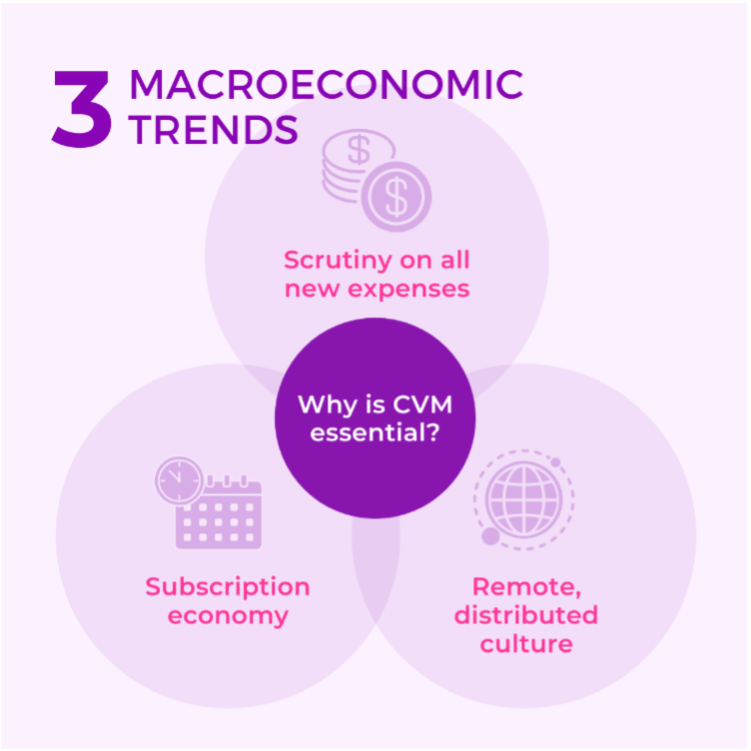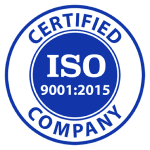
Ultimate Guide to Customer Value Management
What is Customer Value Management?
Customer Value Management represents the consistent, proactive approach to quantifying the operational and financial value that a vendor’s solutions and services can deliver to end customers.
When implemented properly, a vendor regularly quantifies the prospective value that can be provided to a customer throughout the entire customer lifecycle, based on data known or assumed about the customer.
When we do this, conversion rates from first to second meeting are higher, and win rates and deal sizes are larger.
What are the most important elements of success when deploying Customer Value Management?
Organizations must consider two key items when deploying a Customer Value Management program:
Value is not an island

Value Management must live inside of that ecosystem rather than as a distinct motion.
To deploy a value management function does not require ripping or replacing your sales methodology, email automation platform, or content management system. On the contrary, you will obtain a bigger bang for the buck from those systems when you deploy a value management system.
Presenting value cannot feel like going to the dentist…for any participant
So often sales reps and/or customers shudder at the thought of engaging in an ROI or value quantification exercise. This is because the process can be quite lengthy. However, this is not required, nor recommended, particularly in the case of early stage sales cycle discussions.
The best practice is to create a pain and value estimate early in the sales process. The process should take at most 5-10 minutes, and can be faster if available data is used to pre-populate the model.
Why is Customer Value Management Important?
Introduction – In today’s world businesses have been bombarded with a lot of B2B solutions to streamline the business. Since the marketplace is huge, there are a lot of apprehensions among decision-makers as to why they should buy a specific product/service from a particular vendor. This is where customer value management comes into the picture and helps you to quantify benefits, meet customers’ expectations and reduce your sales cycles and a lot more…
Three macroeconomic trends have made Customer Value Management essential.

Scrutiny on all new expenses
With layoffs looming and belts tightening as we enter the second half of 2022, budget owners are forced to consider solutions which have quantifiable value. It’s essential that we equip our advocates to demonstrate how our solutions accelerate revenue or reduce costs or risks.
Subscription economy
The migration to a subscription-based economy has made switching costs for buyers much lower. Subscriptions can be flipped on and off with a switch inside of your Single-sign-on (SSO) platform!
If your budget owner doesn’t understand the ongoing operational value of your solution, they are likely to churn.
Remote, distributed culture
We’ve rapidly evolved to a remote buying and selling culture. Buyers are less efficient, as they can’t assemble huddles or informal sessions to review vendor proposals. Sellers are less able to influence key constituents in the buying process due to their remote locations.
In this climate, sellers must WOW buyers with compelling presentations/ proposals that scream, “See the pain you have, and see the value I can deliver!”
To quantify evidence of business benefits
To most effectively quantify business benefits to buyers, we must do two things:
- Present operational and financial benefits to customers using metrics they are accustomed to using, given their industry
- Summarize the benefits in terms that are compelling to financial leaders (e.g. CFO)
Let’s address each of these separately.
- Present operational and financial benefits to customers using metrics they are accustomed to
How we describe benefits will vary by industry or use case. Another term that is commonly used for such benefits is “value drivers.” Value drivers are the ways that your solution “drives value” for your customers.
Here are a couple of examples:
In healthcare, a provider (doctor’s office, hospital, etc.) measures the following:
- Patient outcomes by type of condition
- Staff, equipment, and facilities costs to deliver those outcomes
- Reimbursements from insurance companies
- Patient loyalty (return rate)
An Information Technology department measures the following:
- Downtime or failure rate per device
- Cost per device per year
- Maintenance cost per device
- Usability ratings and value
- Summarize the benefits in terms that are compelling to financial leaders (e.g. CFO)
With every value analysis, metrics should be presented in the way CFOs like to review and process. Common metrics that CFOs like to review fall into the following buckets:

- Hard cost savings
- Productivity gains
- Revenue acceleration
- Risk mitigation
Especially in an economic downturn, the more effectively we can demonstrate hard cost savings, the better. Hard cost savings represents the actual out-of-pocket savings from payments to third parties.
Financial
- Upfront investment relative to existing spend
- Hard dollar savings in first year
- Payback period
- Capital Expenditure vs. Operating Expenditure comparison/ tradeoff (CapEx vs. OpEx)
- Internal Rate of Return (IRR) (multi-year investment)
- Net Present Value (NPV) (multi-year investment)
The same CFO may be evaluating a purchase for a healthcare solution today, and an IT solution next week. So when we present an ROI or TCO analysis to the different business owners in this organisation, we should include all of these metrics, ideally in different sections so they can be turned on and off as a function of who the recipient is.
Enables Value Selling: Deliver Value Throughout The Customer Journey

It’s challenging for even the best sales and customer success reps to compute and present this information to customers. There is often no consensus internally regarding how to do this. Sometimes reps create spreadsheets to compute this value during a sales cycle. Sometimes customer success reps create spreadsheets to compute value prior to a Quarterly Business Review (QBR).
What if the spreadsheets are different? Or not consistently employed?
Customer Value Management enables your entire GTM team, from marketing, sales, customer success, and partners, to align around a value calculation and presentation approach.
Customers are delighted when the value you present to them 365 days after contract signature is the same format as what you presented during the sales process!
Helps in Maintaining better Business Relationships
It’s very common for a relationship sponsor to leave the customer company, or a customer success manager or sales rep to leave the vendor’s company.
A properly deployed CVM program enables you, the vendor, to engage effectively with new business sponsors, as you have a solid foundation to grow from…leveraging value.
What does a Value Management journey look like?
How to get started with CVM and how long does it take to see the results.
A typical Value Management journey looks like the following:

Phase 1 (4-12 weeks): Complete initial value models
During this phase, the value calculations are developed that describe how your solution delivers cost savings and revenue growth to your customers.
Depending on how many products or solutions your company sells, there may be multiple iterations of this phase.
To execute this phase successfully requires the participation of marketing, sales, and product leadership, so that key constituents are aligned on the elements of the solution’s value.
Existing customer case studies and testimonials should be leveraged, in addition to third party research. These can be wonderful sources for “value drivers” that can populate the model.
We must take a methodical approach to identifying subject matter experts who really get the model and are very passionate about it. And these subject matter experts can fall into different categories:
- Sales reps who really get it. This tends to work if your product is in your value model and is relatively straightforward.
- If you’re in a high tech area or your solution is very complex, it may require a solution engineer or a solution consultant to be that subject matter expert.
The Subject Matter Expert can help lead the end user training, as well as become a frontline support person in the field when there are needs for change requests.
Phase 2 (4-8 weeks): Integrate the calculations with sales and marketing materials
To present the calculations in the most compelling way, the best practice is to leverage the existing sales and marketing materials that have been effectively used with customers: presentations, proposals, marketing content.
It’s helpful to embed dynamic charts, images, and figures into the materials. This helps appeal both to the emotional and the intellectual elements of the brain.
The most effective way to do this is through best-in-class software that populates the key data into the slides.
When we integrate with those marketing assets, we want to have a set of slides which include qualitative information, as well as quantitative information which calculates pain points and value estimates. These charts and slides can include both bar charts as well as visuals with dynamic data overlaid on them.
The key thing when you’re integrating your models with your marketing assets, is to ensure that you have a combination of qualitative information, which is information that customers share about what they care about and what their goals are, and what their pain points are. Some of that information can be collected via a form with drop down boxes, multiple choice, and/or fill in the blank text. It’s also helpful in that section to understand who their current vendors are for different capabilities. There may be opportunities to help your client reduce their spend, or dependence on other solutions, which would become redundant when your solution is introduced?
Phase 3 (2-6 weeks): Deployment to sales team
Deploying value tools to your customer-facing organization is the most important thing to do right to get the biggest return on your program.
During the training you should require each of the sales reps who’s participating in the training to bring one of their existing customer opportunities. Typically a customer prospect would be ideal. But an existing customer where you have more data will work as well.
Conduct a role play between a sales rep and a sales manager who is pretending to be an actual customer…this will be powerful and fun! Offer a reward for the participants.
The goal is to have each rep use the tool at least once or twice in the field in the first 10 to 21 days while that training is fresh, if they don’t use it in those first 10 to 21 days, the likelihood they use it after that is going to be reduced.
After completing the training, you’ll find that you have a handful of reps that’ll really pick it up. When they start to have success, you can come back to retrain the broader team maybe in a couple months. At that time you’ll be able to socialize the success of that initial group.
Phase 4: Integration
So the next section is integration with existing applications and data sources. If you properly integrate this application with your existing CRM solution, your marketing automation solution, and/or third party datasets like zoom info, you may be in a much better position to
gain adoption. You’ll have a data set that you can act upon. It’s a very intelligent data set around where you’re winning and where you’re losing, as a function of key value drivers.
Phase 5: Monitoring and analytics
Finally, analytics. When you deploy the application, it’s important that you have a rich analytics foundation where you can understand which variables are associated with the success of the application. It’s important to have open source.
Choosing a CVM solution with an Open Source stack allows you to synchronize data with different solutions, such as a BI solution
So this is the ultimate guide to Customer Value Management. And this section is about the process and how long it takes to get something of value. So we’ve covered stage one in stage two, which relates to building your models and integrating your models with your marketing assets.
So that’s what we try to achieve in the first section, which is defining a model with enough qualitative and quantitative inputs, that we can build a pain statement and build off that pain statement to develop a value statement. So to achieve this first step, what we want to do is to leverage the existing materials your team may have developed over time including case studies, testimonials and any ROI calculations that you built internally or through analysts.
What Teams Within an Organization Can Benefit From Customer Value Management?
| Teams | Benefits |
|---|---|
| Leadership | Consistency across the team regarding how the company’s value proposition is presented to customers
Visibility into best practices adopted by sales team Lower customer acquisition cost |
| Sales Reps | Higher win rates
Bigger deal sizes Differentiate from competition by looking professional |
| Marketing | Ensure that the claims on your website and collateral are backed up with a tangible presentation of value |
| Customer Success | Embed “value realized” calculations in renewal and quarterly business review presentations, resulting in higher renewal rates and cross-sells |
| Strategic Partners | Equip channel partners to quantify and present the value of your combined solutions |
Table of Contents
- What is Customer Value Management?
- What are the most important elements of success when deploying Customer Value Management?
- Why is Customer Value Management Important?
- What does a Value Management journey look like?
- What teams/Functions/Departments Within an Organization Can Benefit From Customer Value Management?


